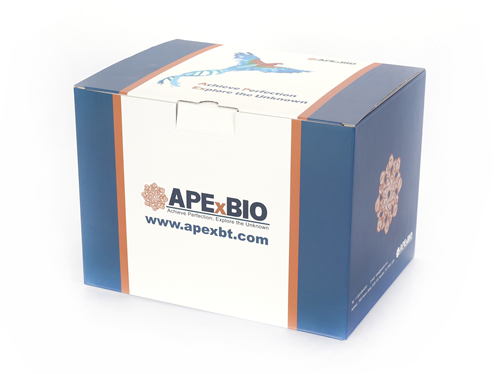- Home
- Signaling Pathways
- Microbiology & Virology
- Antibiotic
- Daunorubicin HCl
- Home
- Lab Reagents
- Antibiotics
- Daunorubicin HCl
Daunorubicin HCl
Daunorubicin HCl is an inhibitor of DNA topoisomerase II [1].
Daunorubicin is an anthracycline antibiotic. It is also used as an effective chemotherapeutic agent against tumors especially acute myeloid leukaemia and acute lymphocytic leukaemia. Daunorubicin can affect the metabolism and synthesis of DNA and RNA. In the in vitro assay, daunorubicin inhibits the incorporation of thymidine and uridine into L1210 cells. It also inhibits the incorporation of labeled precursors into the isolated DNA and RNA from incubated cells. When treated with leukemic cells isolated from acute lymphocytic leukemia patients, daunorubicin significantly inhibits the biosynthesis of the DNA and RNA macromolecules [2, 3].
References:
[1] Hande K R. Etoposide: four decades of development of a topoisomerase II inhibitor. European Journal of Cancer, 1998, 34(10): 1514-1521.
[2] Momparler R L, Karon M, Siegel S E, et al. Effect of adriamycin on DNA, RNA, and protein synthesis in cell-free systems and intact cells. Cancer Research, 1976, 36(8): 2891-2895.
[3] Meriwether W D, Bachur N R. Inhibition of DNA and RNA metabolism by daunorubicin and adriamycin in L1210 mouse leukemia. Cancer research, 1972, 32(6): 1137-1142.
| Storage | Store at -20°C |
| M.Wt | 563.98 |
| Cas No. | 23541-50-6 |
| Formula | C27H30ClNO10 |
| Solubility | ≥28.2 mg/mL in DMSO; insoluble in H2O; ≥2.07 mg/mL in EtOH with gentle warming and ultrasonic |
| Chemical Name | (8S,10S)-8-acetyl-10-(((2R,4S,5S,6S)-4-amino-5-hydroxy-6-methyltetrahydro-2H-pyran-2-yl)oxy)-6,8,11-trihydroxy-1-methoxy-7,8,9,10-tetrahydrotetracene-5,12-dione hydrochloride |
| SDF | Download SDF |
| Canonical SMILES | Cl[H].O=C(C([H])([H])[H])[C@@](C([H])([H])[C@]1([H])O[C@](C([H])([H])[C@]2([H])N([H])[H])([H])O[C@](C([H])([H])[H])([H])[C@@]2([H])O[H])(C([H])([H])C3=C1C(O[H])=C(C(C4=C5C([H])=C([H])C([H])=C4OC([H])([H])[H])=O)C(C5=O)=C3O[H])O[H] |
| Shipping Condition | Small Molecules with Blue Ice, Modified Nucleotides with Dry Ice. |
| General tips | We do not recommend long-term storage for the solution, please use it up soon. |
| Cell experiment [1]: | |
|
Cell lines |
Murine melanoma cells (B16F10) and the murine fibroblast NIH/3T3 |
|
Preparation method |
The solubility of this compound in DMSO is >28.2mg/mL. General tips for obtaining a higher concentration: Please warm the tube at 37℃ for 10 minutes and/or shake it in the ultrasonic bath for a while. Stock solution can be stored below -20℃ for several months. |
|
Reacting condition |
5 to500 μM for 24 h |
|
Applications |
Daunorubicin exerted toxicity against melanoma cells at 15 μM. Daunorubicin caused slight morphology alterations on fibroblast cells and inhibited cell proliferation observed by a decreased cell density when compared with untreated cells. |
| Animal experiment [2]: | |
|
Animal models |
Balb-c mice |
|
Dosage form |
single intraperitoneal , 2.3 to 28.25 μmol/kg |
|
Application |
In Balb-c mice, tumour growth inhibition was slight great in daunorubicin-treated groups at the lower dose (1.8 μmol/kg) while at the higher dose level, tumour growth inhibition under daunorubicin treatment was clearly great (7.5 μmol/kg). All the animals from saline developed metastatic nodes while 80% of daunorubicin-treated groups presented metastatic sites. |
|
Other notes |
Please test the solubility of all compounds indoor, and the actual solubility may slightly differ with the theoretical value. This is caused by an experimental system error and it is normal. |
|
References: [1]. Contente TC, Kretzer IF., et al. Association of daunorubicin to a lipid nanoemulsion that binds to low-density lipoprotein receptors enhances the antitumour action and decreases the toxicity of the drug in melanoma-bearing mice. J Pharm Pharmacol. 2014 Dec;66(12):1698-709. doi: 10.1111/jphp.12296 |
|
Quality Control & MSDS
- View current batch:
Chemical structure















